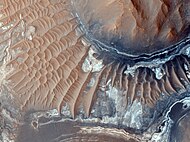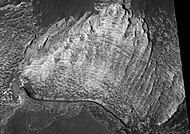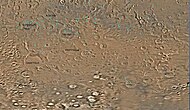火星混沌地形
火星上的混沌地形(Chaos terrain on Mars)極為獨特,地球上沒有與之比似的地貌。混沌地形通常由方圓數幾十公里,高達百米或以上的不規則大地塊群組成,傾斜的平頂地塊形成了數百米深的窪地[1]。一處混沌區域可通過被谷道交錯切割的桌山、地垛和山丘來識別,而一些谷地似乎帶有圖案地面[2][3][4]。這些混沌區的部分區域還沒有完全崩塌,它們仍形成了巨大的台地,因此,可能還貯藏着水冰[5]。混沌地區形成於很久以前,通過隕石坑計數(任何給定區域內的隕坑越多意味着地表越古老)以及研究這些谷地與其他地質特徵的關係,科學家得出結論,這些通道形成於20億至38億年前[6]。
位置
[編輯]混沌地形最集中的區域與巨大古河谷相一致,由於如此多的大型河道似乎起源於混沌地形。因此,人們普遍認為混沌地形是地下釋放出的暴洪所造成[7][8]。大部分混沌地形都分佈於火星高地,位於克律塞平原以南,歐克西亞沼區中以及火星分界沿線,但在珍珠灣區、法厄同區和盧娜沼區中也發現了一些混沌區域。
形成理論
[編輯]有關洪水如何隨混沌地形的形成而釋放的,人們提出了許多種不同的理論。現已發現了與水有關的證據,如混沌區中存在的灰色、結晶赤鐵礦和層狀矽酸鹽等與水有關的礦物[9]。許多關於混沌產生的解釋都涉及巨大的地下冰庫的突然融化。一些研究人員認為,很長一段時間內形成了一層被稱為冰凍圈的凍結層,然後某些事件觸發了它的突然破裂和融化。破裂事件可能為撞擊[10]、岩漿運動[11][12]、地震活動[13]、火山構造應變[14]、孔隙壓力增加或籠狀物分解[15][16][17][18]等。由二氧化碳和甲烷構成的包合物可能發生爆炸性分解,從而液化水飽和的沉積物。一種變體的冰凍圈概念是,含水層與冰凍圈一起形成。隨着越來越多的冰被加入,導致冰凍圈變厚,含水層中的水壓逐步升高[19]。當諸如撞擊或岩漿運動打破或融化了冰凍圈時,巨大壓力下的洪水就會釋放出來。但進一步的計算表明,僅一次釋放尚無法產生出大型河道[20]。後來的提議提出了這樣一種觀點,即混沌地區的地質形態可能是由超過100次的系列洪水事件所造成[21]。
掩埋冰的融化
[編輯]最近,研究人員提出了一種在不需要特殊觸發事件情況下形成混沌地形的理論。塔尼婭·澤格斯(Tanja Zegers)和其他人計算出,簡單掩埋的富冰沉積物可導致大量水流的釋放,從而形成與大多數混沌地形相關的大型河流流域。該小組研究了阿倫混沌,這是一片很大的混沌區域,可能起源於一座大型撞擊坑。在他們的模型中,富冰物質堆積在隕石坑中,然後被沉積物覆蓋,從而阻止了冰消失在稀薄的大氣層中。最終,來自地下深處的熱量與覆蓋層的隔熱性能一起形成了一層厚厚的液態水層。由於緻密的物質容易沉入水中,因此,上覆的岩石在壓力下破裂,緻密的岩蓋破裂成各種大小的傾斜塊體。融化的水流衝到頂部,形成一條通道,隨着水流的湧出,通道受到越來越多的侵蝕。連同來自其他混沌地區的洪水,將有足夠的侵蝕力沖刷出我們現在所看到的大型河谷[22]。有充分的證據表明,冰以冰川的形式埋藏在地下,保存在一層薄薄的岩石和塵土之下[23]。
-
這些圖示顯示了根據澤格斯等人2010年所提出模型的阿拉姆混沌及許多其他混沌地形的形成過程[22],點擊圖片可查看更多的詳情。
-
放大的前一圖像中的矩形區域。在地球上,這種山脊被稱為高山冰川的末端冰磧。HiWish計劃下高解像度成像科學設備在伊斯墨諾斯湖區拍攝的照片。
火星似乎也經歷過很多次冰河期,積冰在冰河期沉積,然後被掩埋。這些冰河期是由該行星頻繁的傾斜大變化所引起[24]。由於缺乏較大的衛星,火星自轉軸傾斜變化很大。對許多隕石坑的觀察表明,很多坑內都填滿了沉積物,冰可能就是其中的一種[25][26][27]。許多隕石坑看上去很淺,但對年輕隕坑的觀察表明,撞擊隕石坑最初應呈碗狀。因此,今天看上去很淺平的隕坑內可能填滿了沉積物[28][29]。2005年,羅德里格斯和其他人發表的研究表明,火星的地下含有大量可能注滿水或冰的古隕坑[30]。
-
火星全球探勘者號顯示的掩埋於另一時代,現因侵蝕而暴露出來的隕石坑。這是火星地下可能分佈有很多被掩埋隕石坑的證據。
富冰層的升華
[編輯]一些混沌區域可能是通過另一種方式所產生,蓋勒克西亞斯混沌就與其他許多混沌區域有所不同,它沒有相關的溢出河道,並且同其他大多數混沌區一樣,與周圍陸地區之間也沒有明顯的高度差。佩德森(Pedersen)和海德(Head)在2010年發表的研究表明,加拉西亞斯混沌是火山流所在地,該火山流掩埋了一層稱為「北方大平原地層組」(VBF)的富冰層[31]。一般認為,北方大平原地層組是大洪水沉積的富水物殘餘[32][33],它可能厚薄不均度,並且含冰量也可能不同。在火星稀薄的大氣層中,這一富冰層會通過升華慢慢消失(從固體直接變成氣體)。由於某些地區可能會比其他區域升華得更多,因此,上部的熔岩蓋會因支撐不均而發生龜裂,裂縫/槽溝可能起始於熔岩蓋邊緣的升華和收縮。岩蓋邊緣破壞產生的應力會在岩蓋上產生裂縫。有裂縫的地方則升華得更多,之後裂縫逐慚擴大,形成混沌區域的塊狀地形特徵。升華過程可能還受到了岩漿運動產生的熱量(地熱通量)促動,附近就坐落有埃律西昂和赫卡特斯火山,其附近很可能蔓延着岩脈,這會加熱地面。此外,過去一段較溫暖的時期也會增加地表水升華量[10]。
-
該系列圖展示了另一種火星混沌地形的形成模型,就如佩德森和海德在2011提出的那樣1[10],升華量被增大以提高理解。點擊圖片可查看更多的細節。
-
背景相機拍攝的蓋勒克西亞斯混沌,下一幅圖像中的場景是該圖中的一部分。
-
高解像度成像科學設備顯示的加拉西亞斯混沌。
重要性
[編輯]混沌地形似乎是過去火星上存在大量水流的有力證據。一些地形並沒有完全破碎,因此可能有更多的水凍結在一些地塊內。
圖集
[編輯]珍珠灣區的混沌區域
[編輯]-
HiWish計劃下高分辨成像科學設備顯示的珍珠灣區的混沌地形。
歐克西亞沼區的混沌區域
[編輯]-
標有主要特徵的歐克西亞沼區域圖,該地區分佈有許多坍塌的混沌區和眾多的溢出河道(古河谷)。
-
顯示了一些混沌區域位置的火星歐克西亞沼區地形圖。
-
顯示可能為水源地的阿倫混沌中的地塊,熱輻射成像系統拍攝於歐克西亞沼區。
-
阿倫混沌中的荒原
-
阿倫混沌的東部地表
-
高解像度成像科學設備顯示的海德拉奧特斯混沌,點擊圖片可查看河道和地層。比例尺長1000米,這照片拍攝於歐克西亞沼區。
-
高解像度成像科學設備顯示的歐克西亞沼區海達斯皮斯混沌。
-
高解像度成像科學設備顯示的歐克西亞沼區厄俄斯混沌中的淺色地層。
法厄同區的混沌區域
[編輯]-
法厄同區地圖,點擊可放大查看部分撞擊坑的名稱,戈耳貢混沌位於地圖頂部附近。
盧娜沼區的混沌區域
[編輯]-
高解像度成像科學設備顯示的伊斯特混沌特寫。
2010年4月1日,美國宇航局發佈了HiWish計劃(由普通大眾為高分辨成像科學設備推薦拍攝地點)下的首批圖像,歐羅姆混沌就是其中八處地點之一[34]。下面的第一張照片展示了該地區的全景,接下來的兩幅圖像來自高解像度成像科學設備照片[35]。
-
跟隨高解像度成像科學設備圖像的廣角熱輻射成像系統圖像。黑框顯示了高解像度成像科學設備圖像的大致位置,該照片只是廣袤的歐羅姆混沌區域的一部分,點擊圖片可查看更多細節。
-
HiWish計劃下高解像度成像科學設備顯示的歐羅姆混沌。
-
前一幅圖像的特寫版,小圓點是巨石。
另請查看
[編輯]參考文獻
[編輯]- ^ Meresse, S.; et al. Formation and evolution of the chaotic terrains by subsidence and magmatism: Hydraotes Chaos, Mars. Icarus. 2008, 194 (2): 487–500. Bibcode:2008Icar..194..487M. doi:10.1016/j.icarus.2007.10.023.
- ^ Sharp, R. Mars: Fretted and chaotic terrains (PDF). J. Geophys. Res. 1973, 78 (20): 4073–4083 [2022-03-23]. Bibcode:1973JGR....78.4073S. doi:10.1029/JB078i020p04073. (原始內容 (PDF)存檔於2021-07-24).
- ^ Carr, M. 2006. The Surface of Mars. Cambridge University Press. ISBN 978-0-521-87201-0
- ^ Forget, F., et al. 2006. Planet Mars Story of Another World. Praxis Publishing, Chichester, UK. ISBN 978-0-387-48925-4
- ^ Unraveling the Chaos of Aram | Mars Odyssey Mission THEMIS. [2022-03-23]. (原始內容存檔於2009-01-07).
- ^ When Chaos Erupted in Hydraotes | Mars Odyssey Mission THEMIS. [2022-03-23]. (原始內容存檔於2021-01-20).
- ^ Carr, M. 1978. Formation of martian flood features by release of water from confined aquifers. NASA Technical Memorandum 79729. 260-262.
- ^ Carr, M. Formation of martian flood features by release of water from confined aquifers. J. Geophys. Res. 1979, 84: 2995–3007. Bibcode:1979JGR....84.2995C. doi:10.1029/JB084iB06p02995.
- ^ Glotch, Timothy D. Geologic and mineralogic mapping of Aram Chaos: Evidence for a water-rich history. Journal of Geophysical Research. 2005, 110. Bibcode:2005JGRE..11009006G. doi:10.1029/2004JE002389
 .
.
- ^ 10.0 10.1 10.2 Pedersen, G.; Head, J. Chaos formation by sublimation of volatile-rich substrate: evidence from Galaxias Chaos, Mars. Icarus. 2011, 211 (1): 316–329. Bibcode:2011Icar..211..316P. doi:10.1016/j.icarus.2010.09.005.
- ^ Chapman, M.; Tanaka, K. Related magma-ice interactions: Possible origins of Chasma chaos and surface materials in Xanthe, Margaritifer, and Merdiani Terrae, Mars. Icarus. 2002, 155 (2): 324–339 [2022-03-23]. Bibcode:2002Icar..155..324C. doi:10.1006/icar.2001.6735. (原始內容存檔於2022-03-31).
- ^ Head, J. and L. Wilson. 2002. Mars: A review and synthesis of general environments and geological settings of Magma-H2O interactions. In: SmeilieJ. And M. Chapman. (EDS.). Volcanic-ice Interactions on Earth and Mars. Geological Society. London
- ^ Tanaka, K. Debris-flow origin for Simud/Tiu deposits on Mars. J. Geophys. Res. 1999, 104 (E4): 8637–8652. Bibcode:1999JGR...104.8637T. doi:10.1029/98JE02552
 .
.
- ^ Cabrol, Nathalie A.; et al. A model of outflow generation by hydrothermal underpressure drainage in volcano-tectonic environment. Shalbatana Vallis (Mars). Icarus. 1997, 125 (2): 455–464. Bibcode:1997Icar..125..455C. doi:10.1006/icar.1996.5625.
- ^ Milton, DJ. Carbon dioxide hydrate and floods on Mars. Science. 1974, 183 (4125): 654–656. Bibcode:1974Sci...183..654M. PMID 17778840. S2CID 26421605. doi:10.1126/science.183.4125.654.
- ^ Hoffmann, H. White Mars: A new model for Mars' surface and atmosphere based CO2. Icarus. 2000, 146 (2): 326–342. Bibcode:2000Icar..146..326H. doi:10.1006/icar.2000.6398.
- ^ Komatsu, G. et al. 2000. A chaotic terrain formation hypothesis: Explosive outgas and outflow by dissociation of clathrate on Mars. Lunar Planet. Sci. XXXI. 1434.
- ^ Rodriguez, J. A. P.; Kargel, Jeffrey; Crown, David A.; Bleamaster, Leslie F.; Tanaka, Kenneth L.; Baker, Victor; Miyamoto, Hideaki; Dohm, James M.; Sasaki, Sho; Komatsu, Goro. Headward growth of chasmata by volatile outbursts, collapse, and drainage: Evidence from Ganges chaos, Mars. Geophysical Research Letters. 2006, 33 (18): 18203. Bibcode:2006GeoRL..3318203R. doi:10.1029/2006GL026275
 .
.
- ^ Clifford, S. A model for the hydrologic and climatic behaviour of water on mars. J. Geophys. Res. 1993, 98 (E6): 10973–11016. Bibcode:1993JGR....9810973C. doi:10.1029/93JE00225.
- ^ Baker, V. Water and the martian landscape. Nature. 2001, 412 (6843): 228–236. Bibcode:2001Natur.412..228B. PMID 11449284. doi:10.1038/35084172
 .
.
- ^ Harrison, Keith P.; Grimm, Robert E. Multiple flooding events in Martian outflow channels. Journal of Geophysical Research. 2008, 113 (E2): E02002. Bibcode:2008JGRE..113.2002H. doi:10.1029/2007je002951.
- ^ 22.0 22.1 Zegers, T.; et al. Melt and collapse of buried water ice: An alternative hypothesis for the formation of chaotic terrains on Mars. Earth and Planetary Science Letters. 2010, 297 (3–4): 496–504. Bibcode:2010E&PSL.297..496Z. doi:10.1016/j.epsl.2010.06.049.
- ^ Head, J.; Neukum, G.; Jaumann, R.; Hiesinger, H.; Hauber, E.; Carr, M.; Masson, P.; Foing, B.; Hoffmann, H.; et al. Tropical to mid-latitude snow and ice accumulation, flow and glaciation on Mars. Nature. 2005, 434 (7031): 346–350. Bibcode:2005Natur.434..346H. PMID 15772652. S2CID 4363630. doi:10.1038/nature03359.
- ^ Head, J.; et al. Extensive valley glacier deposits in the northern mid-latitudes of Mars: Evidence for the late Amazonian obliquity-driven climate change. Earth Planet. Sci. Lett. 2006, 241 (3–4): 663–671. Bibcode:2006E&PSL.241..663H. doi:10.1016/j.epsl.2005.11.016.
- ^ Madeleine, J. et al. 2007. Mars: A proposed climatic scenario for northern mid-latitude glaciation. Lunar Planet. Sci. 38. Abstract 1778.
- ^ Madeleine, J.; Forget, F.; Head, James W.; Levrard, B.; Montmessin, F.; Millour, E. Amazonian northern mid-latitude glaciation on Mars: A proposed climate scenario (PDF). Icarus. 2009, 203 (2): 300–405 [2022-03-23]. Bibcode:2009Icar..203..390M. doi:10.1016/j.icarus.2009.04.037. (原始內容 (PDF)存檔於2022-03-23).
- ^ Mischna, M.; Richardson, Mark I.; Wilson, R. John; McCleese, Daniel J. On the orbital forcing of martian water and CO2 cycles: A general circulation model study with simplified volatile schemes. J. Geophys. Res. 2003, 108 (E6): 5062. Bibcode:2003JGRE..108.5062M. doi:10.1029/2003JE002051
 .
.
- ^ Parker, M.; et al. 3D structure of the Gusev Crater region. Earth and Planetary Science Letters. 2010, 294 (3–4): 411–423. Bibcode:2010E&PSL.294..411P. doi:10.1016/j.epsl.2010.01.013.
- ^ Kreslavsky, M.; Head, J. Modification of impact craters in the northern plains of Mars: Implications for the Amazonian climate history. Meteorit. Planet. Sci. 2006, 41 (10): 1633–1646. Bibcode:2006M&PS...41.1633K. doi:10.1111/j.1945-5100.2006.tb00441.x
 .
.
- ^ Rodríguez, Jose Alexis Palmero. Control of impact crater fracture systems on subsurface hydrology, ground subsidence, and collapse, Mars. Journal of Geophysical Research. 2005, 110. Bibcode:2005JGRE..11006003R. doi:10.1029/2004JE002365
 .
.
- ^ Pedersen, G., J. Head. 2010. Chaos formation by sublimation of volatile-rich substrate: Evidence from Galaxias Chaos, Mars. Icarus: 211, 316–329.
- ^ Kreslavsky, Mikhail A.; Head, James W. Fate of outflow channel effluents in the northern lowlands of Mars: The Vastitas Borealis Formation as a sublimation residue from frozen ponded bodies of water. Journal of Geophysical Research. 2002, 107 (E12): 4–1–4–25. Bibcode:2002JGRE..107.5121K. doi:10.1029/2001JE001831
 .
.
- ^ Carr, Michael H.; Head, James W. Oceans on Mars: An assessment of the observational evidence and possible fate (PDF). Journal of Geophysical Research. 2003, 108 (E5): 5042 [2022-03-23]. Bibcode:2003JGRE..108.5042C. doi:10.1029/2002JE001963. (原始內容 (PDF)存檔於2017-08-09).
- ^ HiRISE | Captioned Image Inspired by HiWish Suggestions. Uahirise.org. [2022-03-21]. (原始內容存檔於2012-03-09).
- ^ HiRISE | Mesas in Aureum Chaos (ESP_016869_1775). [2022-03-23]. (原始內容存檔於2016-10-03).


![這些圖示顯示了根據澤格斯等人2010年所提出模型的阿拉姆混沌及許多其他混沌地形的形成過程[22],點擊圖片可查看更多的詳情。](http://upload.wikimedia.org/wikipedia/commons/thumb/f/f2/Aramchaoscomplete3.jpg/127px-Aramchaoscomplete3.jpg)




![該系列圖展示了另一種火星混沌地形的形成模型,就如佩德森和海德在2011提出的那樣1[10],升華量被增大以提高理解。點擊圖片可查看更多的細節。](http://upload.wikimedia.org/wikipedia/commons/thumb/f/f8/Galaxiascomplete2.jpg/127px-Galaxiascomplete2.jpg)






















